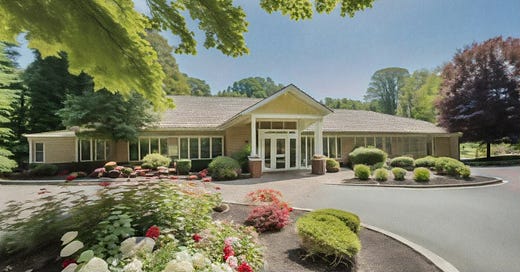A Practical Guide To Senior Living Choices: Resident Care Homes
A different choice altogether. . .
Resident care homes are located in traditional houses in residential neighborhoods and, as a result, are difficult to pigeonhole by consistent characteristics.
No two resident care homes are exactly alike in design, services, personnel, cost parameters, entrance qualification and, depending on where you are searching geographically, whether there is a state licensing requirement concerning levels of care and services provided.
Complicating matters further, residential care homes are also known as board and care homes, personal care homes, and adult family care homes, all with small but potentially significant differences.
If residential care homes become a top choice to fulfill your loved one’s needs, you’ll have to be extra thorough in investigating your top choices.
Resident care homes vs. assisted living
In terms we’ve been using for senior community living, residential care homes most resemble assisted living in the care that can be provided for the residents, but the total number of residents is tiny in comparison.
Whereas true assisted living generally means a corporately owned building of rentable private apartments, care homes are privately owned residential houses that have become a business.
The number of residents residing in each home will vary (the nationwide average is 8-10 residents) depending on the house size. However, unlike assisted living, you are more likely to find shared bedrooms mixed in with private ones—some sharing bathrooms, some not.
Living rooms, kitchens, dining rooms, and possible porches or patios will also be common spaces for residents to share.
In every situation, you’ll find a supervised, small group environment with personalized care services designed to meet various needs.
Like assisted living communities, resident care homes are designed for seniors who can no longer live well and safely alone but do not need 24-hour nursing care.
Resident care homes can be found nationwide, but the number of dwellings varies widely from state to state. Unlike assisted living, which is state regulated, resident care homes may or may not have state licensing requirements about levels of care, services, and staff.
A benchmark for comparison
California has the highest number of resident care homes, called Resident Care Facilities for the Elderly (RCFE), and the tightest licensing requirements: each home operates under the state standards mandated by the California Department of Social Services, Community Care License Division.
Every California RCFE has an on-site inspection every five years, with non-compliant locations inspected annually.
This rulemaking and enforcement create uniformity within the California offerings and, for our purposes, make their resident care homes easier to use as a benchmark for a product that might work for you. Clearly, not all readers will be looking at California, but it provides a starting point from which you can compare.
Services
California Resident Care Homes position themselves as having six to fifteen beds, which puts them between assisted living (sixteen-plus beds) and board and care homes (four to six beds). RCFEs are locally owned and offer:
Room and board
Housekeeping
Supervision
Personal care assistance
Hygiene
Dressing
Transfering
Eating
Walking
Limiting factors:
No tube feedings
No treatment of open bedsores
Nothing that requires twenty-four hour nursing care, such as IV treatments
Check each facility for specifics
As a non-medical facility, RCFEs aren’t required to have registered nurses and certified nursing assistants on staff. This requirement is most commonly met on a shift basis. Occasionally, the owner and/or supervisor who lives in the community could be an R.N., but there is no requirement.
Costs
The cost of residing in California’s RCFEs varies significantly and is the same throughout other states.
The low end of the cost, $1,000 per month in California, reflects those residents living on Supplemental Security Income (SSI) to Medicaid equivalent. Like most states, they want you to pay privately for a year or two before converting to the low-income rate.
The high end of the RCFEs reaches $9,000 or more per month, driven by the higher cost of dementia and hospice care that require more one-on-one supervision.
The 2025 median cost of rent in California resident care homes is $5,000/month for a private room and $4,000/month for a semi-private room.
Characteristics to inquire about
Generally speaking, these characteristics—based on the uniformity derived from California’s resident care facilities—apply to other states’ resident care homes and are worth asking for information.
There may or may not be state licensing requirements
Bedrooms are private or shared
Standard services: supervision, meals, snacks, limited activities or entertainment
Custodial care: laundry, housekeeping, transportation to doctor
Varying levels of assistance (all non-medical) and likely incremental cost: toileting, bathing, dressing, transferring, eating, walking
Medication reminders or administration
Generally nursing oversight but not at all times
Staff can range from R.N. to recent immigrants; homeowners could live-in; shifts of caregivers likely (inquire about background checks)
Some allow hospice (by license waiver)
Some allow non-ambulatory needs (if applicable, check each facility to be sure)
Who might consider a residential care home?
Like any other option in senior community living, the “fit” between the home and our loved one has to be good.
I’ve seen seniors overwhelmed by the appearance of assisted living communities that seem too big or too fancy. Or, perhaps an assisted living community has too many residents and staff members who are “always on the go” caring for them. It’s possible a residential care home—a smaller, home-like setting—would work better and feel more comfortable for seniors with those concerns.
You’ll be the one to decide if residential care homes are a viable option for your loved one’s situation.
If you decide to go in that direction, plan to visit often and dig deep with your questions. Ask about their license (check through your state Department of Aging). Ask what health crisis or condition could make remaining there impossible. Ask which family members of past or current residents would be open to speaking with you by phone about the home and its care.
Conclusion
If your loved one might do better in a small community of seniors who reside together in an actual house with supervised living and help with personal care, then by all means, investigate the option of residential care homes.
The best operators will talk to you about promoting a healthy lifestyle and offering their residents a wide range of “community” and social opportunities. Beyond socialization, they’ll talk about providing a high quality of life while caring for their basic healthcare needs with services. Trust yourself.
You’ll know if it’s the right “fit” at the right time when you experience it: it will feel right to you and your loved one.
As always, I wish you and yours the good fortune of finding a perfect “fit” that feels like home.
RESEARCH sites: resident care homes
https://canhr.org — California Advocates for Nursing Home Reform Statewide is a nonprofit (501c3) advocacy organization for improving California's long-term care consumers' choices, care, and quality of life through education and support (founded 1983).
https://dhcs.ca.gov — California Department of Healthcare Services is the “backbone of California’s health care safety net.
https://cdss.ca.gov/cdssweb/entres/forms/English/LIC9201.pdf — Annual Regulation Compliance Checklist: Adult Residential Facility.
https://cdss.ca.gov/Portals/9/CCLD/OHC-ResourceGuide-ARF.pdf — Choosing a Residential Care Facility for Adults in California: A Guide for Consumers.
PREVIEW of WHAT’S COMING NEXT:
In the weeks ahead, I’ll guide you through the individual types of Community Living, which are generally on different campuses. Two or even three are sometimes combined on the same campus.
Memory Care
Continuing Care Retirement Communities
I hope you’ll return each week for “insider” tips about each structure, questions to ask, and what to look for in the community.
Thank you for being here! Please ❤️ (below) if you enjoyed this piece. Your feedback, as well as comments and reposts, helps others find my articles and posts.
Having been where you are—with both of my parents and hundreds of families seeking residency in senior community living for their loved ones—I know this is hard but important work. I wish you and yours the best results.
If you know someone who’s struggling with caregiving demands, please feel free to share my articles at any point. Thanks, and see you soon.
Graceful Last Chapters: Helping Seniors Who Need More Care
Cynthia Neher Martindale, author
"Kind, intelligent, informative, patient, and humanitarian." -- Amazon TOP 100 REVIEWER







I had no idea that this was even a thing. I doubt it would have been an option for my father as the psychiatrist insisted that he needed locked down memory care but it's something to keep in mind for the future.
Thank you for another option for our seniors. I never knew these homes existed; it was a real surprise, frankly. You gave us a clear picture of their possibilities and probing questions to ask. Once again you provided a real service to caregivers around the country and possibly around the world. I look forward to learning more.